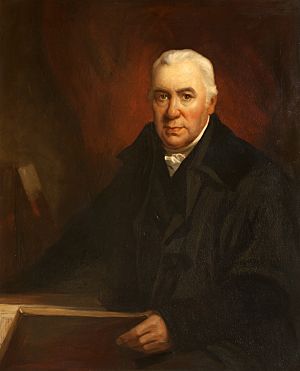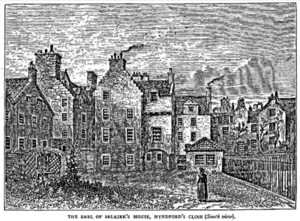Daniel Rutherford facts for kids
Quick facts for kids
Daniel Rutherford
|
|
|---|---|
 |
|
| Born | 3 November 1749 Edinburgh, Scotland
|
| Died | 15 December 1819 (aged 70) Edinburgh, Scotland
|
| Alma mater | University of Edinburgh |
| Known for | isolation of nitrogen |
| Scientific career | |
| Fields | chemistry |
| Institutions | Physician, Edinburgh (1775–86) Professor of medicine and botany, University of Edinburgh Keeper, Royal Botanic Garden, Edinburgh (1786–1819) King's Botanist in Scotland (1786-) Physician, Edinburgh Royal Infirmary (1791) |
| Influences | Joseph Black |
| Author abbrev. (botany) | Rutherf. |
Daniel Rutherford (born November 3, 1749 – died December 15, 1819) was a Scottish doctor, chemist, and botanist. He is most famous for discovering and isolating the element nitrogen in 1772. This was a very important step in understanding what air is made of.
Contents
Life and Education
Daniel Rutherford was born in Edinburgh, Scotland. His father, Professor John Rutherford, was also a well-known doctor.
Daniel started college at age 16 at Mundell's School. He then went on to study medicine at the University of Edinburgh. There, he learned from famous scientists like William Cullen and Joseph Black. He earned his medical degree in 1772.
After finishing his studies, Rutherford worked as a doctor in Edinburgh from 1775 to 1786.
Important Roles and Contributions
Daniel Rutherford was involved in many important scientific groups. In 1783, he helped start the Royal Society of Edinburgh. This is a famous group for scientists in Scotland.
He became a professor of botany (the study of plants) at the University of Edinburgh. From 1786 to 1819, he was also the head of the Royal Botanic Garden, Edinburgh. This is a large and important garden where plants are studied and grown. He also served as the president of the Royal College of Physicians of Edinburgh from 1796 to 1798.
Rutherford lived in Edinburgh for his whole life. He passed away suddenly in 1819.
Discovering Nitrogen
Daniel Rutherford's most famous discovery was isolating nitrogen in 1772. This happened while he was working with his teacher, Joseph Black.
Black was studying carbon dioxide and noticed that a candle could not burn in it. He asked Rutherford to investigate further.
The Experiment
Rutherford did a clever experiment to understand what was left in the air after things stopped burning or living.
- First, he put a mouse in a closed space with a small amount of air. The mouse eventually died.
- Next, he burned a candle in the remaining air until it went out.
- After that, he burned phosphorus in the air until it also stopped burning.
- Finally, he passed the air through a special liquid that absorbed all the carbon dioxide.
What was left was a gas that could not support burning, and a mouse could not live in it.
"Noxious Air"
Rutherford called this new gas "noxious air" or "phlogisticated air." Today, we know this gas is mostly nitrogen. His experiment was a big step in showing that air is not just one simple substance, but a mixture of different gases. At the time, scientists believed in something called the phlogiston theory, which was an early idea about how things burn. Rutherford and Black explained their findings using this theory.
See also
 In Spanish: Daniel Rutherford para niños
In Spanish: Daniel Rutherford para niños


